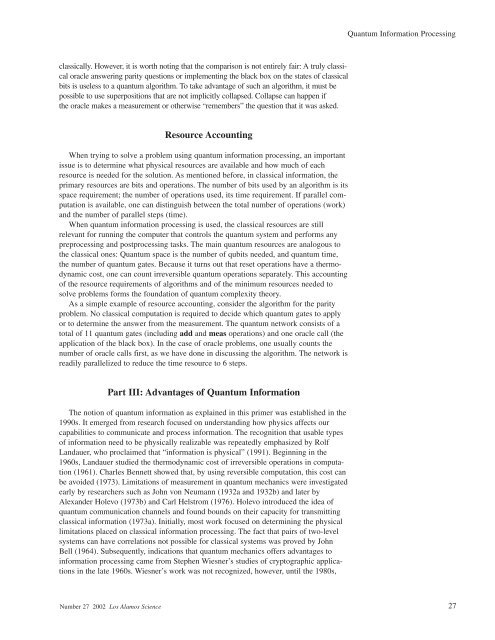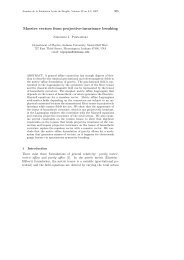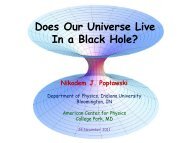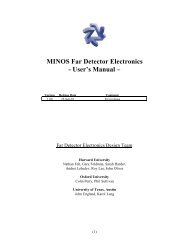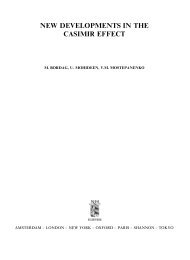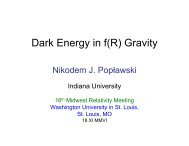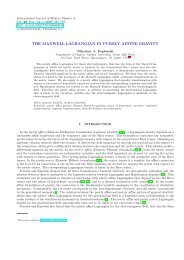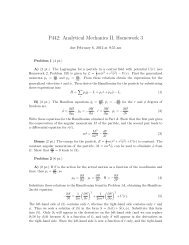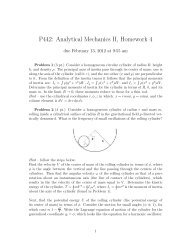Quantum Information Processing
Quantum Information Processing
Quantum Information Processing
You also want an ePaper? Increase the reach of your titles
YUMPU automatically turns print PDFs into web optimized ePapers that Google loves.
classically. However, it is worth noting that the comparison is not entirely fair: A truly classical<br />
oracle answering parity questions or implementing the black box on the states of classical<br />
bits is useless to a quantum algorithm. To take advantage of such an algorithm, it must be<br />
possible to use superpositions that are not implicitly collapsed. Collapse can happen if<br />
the oracle makes a measurement or otherwise “remembers” the question that it was asked.<br />
Resource Accounting<br />
When trying to solve a problem using quantum information processing, an important<br />
issue is to determine what physical resources are available and how much of each<br />
resource is needed for the solution. As mentioned before, in classical information, the<br />
primary resources are bits and operations. The number of bits used by an algorithm is its<br />
space requirement; the number of operations used, its time requirement. If parallel computation<br />
is available, one can distinguish between the total number of operations (work)<br />
and the number of parallel steps (time).<br />
When quantum information processing is used, the classical resources are still<br />
relevant for running the computer that controls the quantum system and performs any<br />
preprocessing and postprocessing tasks. The main quantum resources are analogous to<br />
the classical ones: <strong>Quantum</strong> space is the number of qubits needed, and quantum time,<br />
the number of quantum gates. Because it turns out that reset operations have a thermodynamic<br />
cost, one can count irreversible quantum operations separately. This accounting<br />
of the resource requirements of algorithms and of the minimum resources needed to<br />
solve problems forms the foundation of quantum complexity theory.<br />
As a simple example of resource accounting, consider the algorithm for the parity<br />
problem. No classical computation is required to decide which quantum gates to apply<br />
or to determine the answer from the measurement. The quantum network consists of a<br />
total of 11 quantum gates (including add and meas operations) and one oracle call (the<br />
application of the black box). In the case of oracle problems, one usually counts the<br />
number of oracle calls first, as we have done in discussing the algorithm. The network is<br />
readily parallelized to reduce the time resource to 6 steps.<br />
Part III: Advantages of <strong>Quantum</strong> <strong>Information</strong><br />
The notion of quantum information as explained in this primer was established in the<br />
1990s. It emerged from research focused on understanding how physics affects our<br />
capabilities to communicate and process information. The recognition that usable types<br />
of information need to be physically realizable was repeatedly emphasized by Rolf<br />
Landauer, who proclaimed that “information is physical” (1991). Beginning in the<br />
1960s, Landauer studied the thermodynamic cost of irreversible operations in computation<br />
(1961). Charles Bennett showed that, by using reversible computation, this cost can<br />
be avoided (1973). Limitations of measurement in quantum mechanics were investigated<br />
early by researchers such as John von Neumann (1932a and 1932b) and later by<br />
Alexander Holevo (1973b) and Carl Helstrom (1976). Holevo introduced the idea of<br />
quantum communication channels and found bounds on their capacity for transmitting<br />
classical information (1973a). Initially, most work focused on determining the physical<br />
limitations placed on classical information processing. The fact that pairs of two-level<br />
systems can have correlations not possible for classical systems was proved by John<br />
Bell (1964). Subsequently, indications that quantum mechanics offers advantages to<br />
information processing came from Stephen Wiesner’s studies of cryptographic applications<br />
in the late 1960s. Wiesner’s work was not recognized, however, until the 1980s,<br />
<strong>Quantum</strong> <strong>Information</strong> <strong>Processing</strong><br />
Number 27 2002 Los Alamos Science 27


